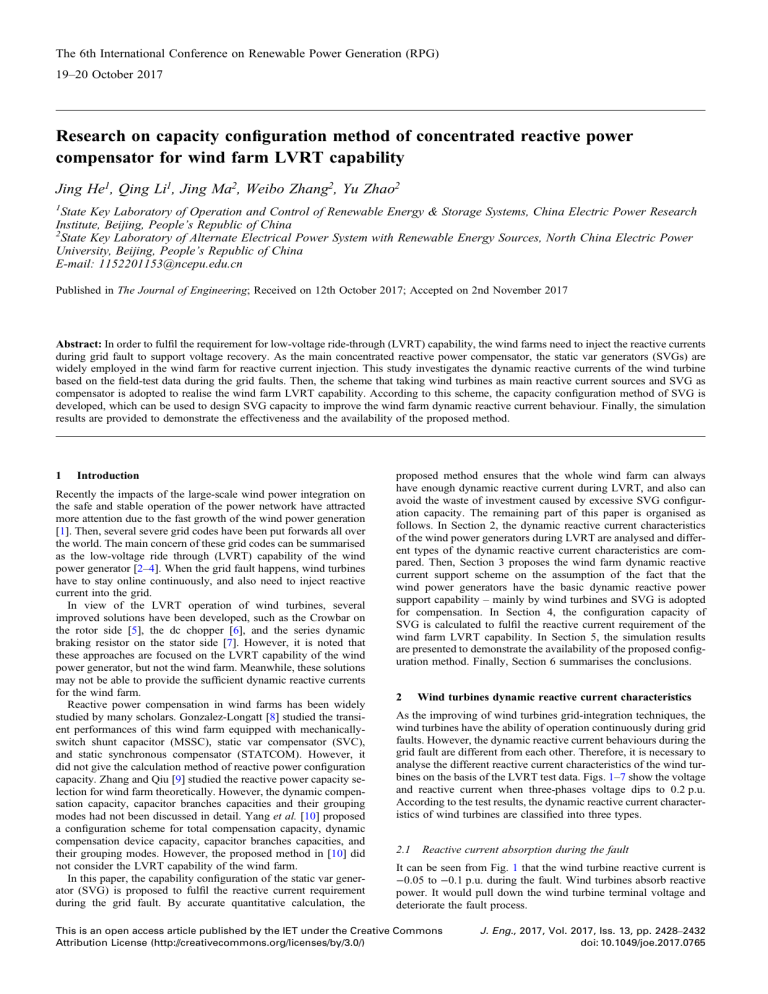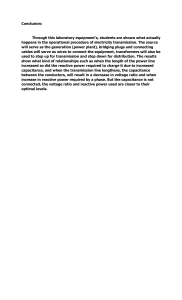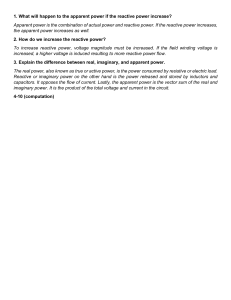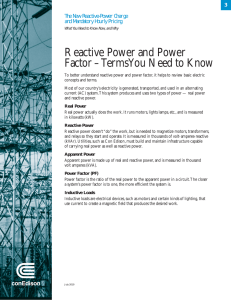Wind Farm LVRT Capability: Reactive Power Compensator Configuration
advertisement

The 6th International Conference on Renewable Power Generation (RPG) 19–20 October 2017 Research on capacity configuration method of concentrated reactive power compensator for wind farm LVRT capability Jing He1, Qing Li1, Jing Ma2, Weibo Zhang2, Yu Zhao2 1 State Key Laboratory of Operation and Control of Renewable Energy & Storage Systems, China Electric Power Research Institute, Beijing, People’s Republic of China 2 State Key Laboratory of Alternate Electrical Power System with Renewable Energy Sources, North China Electric Power University, Beijing, People’s Republic of China E-mail: 1152201153@ncepu.edu.cn Published in The Journal of Engineering; Received on 12th October 2017; Accepted on 2nd November 2017 Abstract: In order to fulfil the requirement for low-voltage ride-through (LVRT) capability, the wind farms need to inject the reactive currents during grid fault to support voltage recovery. As the main concentrated reactive power compensator, the static var generators (SVGs) are widely employed in the wind farm for reactive current injection. This study investigates the dynamic reactive currents of the wind turbine based on the field-test data during the grid faults. Then, the scheme that taking wind turbines as main reactive current sources and SVG as compensator is adopted to realise the wind farm LVRT capability. According to this scheme, the capacity configuration method of SVG is developed, which can be used to design SVG capacity to improve the wind farm dynamic reactive current behaviour. Finally, the simulation results are provided to demonstrate the effectiveness and the availability of the proposed method. 1 Introduction Recently the impacts of the large-scale wind power integration on the safe and stable operation of the power network have attracted more attention due to the fast growth of the wind power generation [1]. Then, several severe grid codes have been put forwards all over the world. The main concern of these grid codes can be summarised as the low-voltage ride through (LVRT) capability of the wind power generator [2–4]. When the grid fault happens, wind turbines have to stay online continuously, and also need to inject reactive current into the grid. In view of the LVRT operation of wind turbines, several improved solutions have been developed, such as the Crowbar on the rotor side [5], the dc chopper [6], and the series dynamic braking resistor on the stator side [7]. However, it is noted that these approaches are focused on the LVRT capability of the wind power generator, but not the wind farm. Meanwhile, these solutions may not be able to provide the sufficient dynamic reactive currents for the wind farm. Reactive power compensation in wind farms has been widely studied by many scholars. Gonzalez-Longatt [8] studied the transient performances of this wind farm equipped with mechanicallyswitch shunt capacitor (MSSC), static var compensator (SVC), and static synchronous compensator (STATCOM). However, it did not give the calculation method of reactive power configuration capacity. Zhang and Qiu [9] studied the reactive power capacity selection for wind farm theoretically. However, the dynamic compensation capacity, capacitor branches capacities and their grouping modes had not been discussed in detail. Yang et al. [10] proposed a configuration scheme for total compensation capacity, dynamic compensation device capacity, capacitor branches capacities, and their grouping modes. However, the proposed method in [10] did not consider the LVRT capability of the wind farm. In this paper, the capability configuration of the static var generator (SVG) is proposed to fulfil the reactive current requirement during the grid fault. By accurate quantitative calculation, the proposed method ensures that the whole wind farm can always have enough dynamic reactive current during LVRT, and also can avoid the waste of investment caused by excessive SVG configuration capacity. The remaining part of this paper is organised as follows. In Section 2, the dynamic reactive current characteristics of the wind power generators during LVRT are analysed and different types of the dynamic reactive current characteristics are compared. Then, Section 3 proposes the wind farm dynamic reactive current support scheme on the assumption of the fact that the wind power generators have the basic dynamic reactive power support capability – mainly by wind turbines and SVG is adopted for compensation. In Section 4, the configuration capacity of SVG is calculated to fulfil the reactive current requirement of the wind farm LVRT capability. In Section 5, the simulation results are presented to demonstrate the availability of the proposed configuration method. Finally, Section 6 summarises the conclusions. 2 Wind turbines dynamic reactive current characteristics As the improving of wind turbines grid-integration techniques, the wind turbines have the ability of operation continuously during grid faults. However, the dynamic reactive current behaviours during the grid fault are different from each other. Therefore, it is necessary to analyse the different reactive current characteristics of the wind turbines on the basis of the LVRT test data. Figs. 1–7 show the voltage and reactive current when three-phases voltage dips to 0.2 p.u. According to the test results, the dynamic reactive current characteristics of wind turbines are classified into three types. 2.1 Reactive current absorption during the fault It can be seen from Fig. 1 that the wind turbine reactive current is −0.05 to −0.1 p.u. during the fault. Wind turbines absorb reactive power. It would pull down the wind turbine terminal voltage and deteriorate the fault process. This is an open access article published by the IET under the Creative Commons Attribution License (http://creativecommons.org/licenses/by/3.0/) J. Eng., 2017, Vol. 2017, Iss. 13, pp. 2428–2432 doi: 10.1049/joe.2017.0765 Fig. 2 No reactive current injection during the fault Fig. 5 0.6 p.u. reactive current output during the fault Fig. 6 DFIG wind turbine with 1.2 p.u. reactive current output Fig. 7 Direct-drive wind turbine with 1.05 p.u. reactive current output Fig. 3 0.2 p.u. reactive current output during the fault 2.2 No reactive current injection during the fault It can be seen from Fig. 2 that the wind turbine reactive current is about zero during the fault. It does not have the dynamic reactive power support capacity. 2.3 Reactive current injection during the fault Fig. 4 0.4 p.u. reactive current output during the fault Most wind turbines provide reactive power during the fault, but the reactive current support is different due to the different control strategy. Figs. 3–5 show that when the wind turbine’s terminal voltage dropped to 0.2 p.u., the reactive current is 0.2–0.6 p.u. Wind farm with these wind turbines cannot meet the grid code requirement. Figs. 6 and 7 show more than 1.0 p.u. dynamic reactive current injection of DFIG wind turbine and direct-drive wind turbine. A wind farm with these wind turbines may fulfil the grid code requirement. J. Eng., 2017, Vol. 2017, Iss. 13, pp. 2428–2432 doi: 10.1049/joe.2017.0765 This is an open access article published by the IET under the Creative Commons Attribution License (http://creativecommons.org/licenses/by/3.0/) 20513305, 2017, 13, Downloaded from https://ietresearch.onlinelibrary.wiley.com/doi/10.1049/joe.2017.0765, Wiley Online Library on [06/11/2023]. See the Terms and Conditions (https://onlinelibrary.wiley.com/terms-and-conditions) on Wiley Online Library for rules of use; OA articles are governed by the applicable Creative Commons License Fig. 1 Absorbing reactive current during the fault Itur = 1.5(0.9 − Utur ) (1) where Utur is the per unit value of wind turbine terminal voltage, Itur is the wind turbine reactive current, respectively. The dynamic reactive current support of wind farm mainly based on wind turbines, but due to a reactive power loss of transformers and transmission lines, the reactive current at wind farm POI (point of integration) will less than grid code requirement, the reactive compensation device is needed. Thus, taking wind turbines as main reactive current sources, and the SVG as compensator can be used to realise the whole wind farm dynamic reactive current supporting ability. 3 Operation principle of SVG As the dynamic reactive power compensator, the SVG is used for the transient voltage fault support [11]. Based on the concept of the instantaneous reactive power and the compensation principle, the SVG can quickly provide the reactive current to maintain the system voltage stability and improve the wind farm LVRT capacity [12, 13]. If the SVG has the LVRT capability, it normally operates at the rated reactive current to support the voltage when grid fault. In Fig. 8, Us, UA, and Udc are the network voltage, the output voltage, and the dc voltage, respectively. δ is the angle between Us and UA, neglecting the resistance, the reactive power of SVG can be calculated as Q= Us (Us − UA cos d) X (2) where X is the line impedance. SVG voltage/current (U/I ) characteristics are shown in Fig. 9, the solid line represents the working area of the SVG within the rated current range, and the dotted line indicates the working range of the SVG during overload operation. The SVG can provide the capacitive or inductive reactive power within the operating voltage range, and then control the output current within the rated current range. When the voltage decreases or increases to a certain value, SVG becomes a constant current source limited by the capacity of the electrical devices. The reactive current output is independent of the voltage, but the reactive power output is in proportion to the voltage. Therefore, during the grid fault, the reactive current of the SVG can be assumed as constant, and its value is equal to rated current. If the rated current of the SVG is determined, the rated capacity of SVG is determined. 4 Configuration capacity calculation of SVG for dynamic reactive current support According to the requirements of GB/T 19963-2011, when the voltage at the point of interconnection (POI) of the wind farm is between 20 and 90% of nominal voltage, the per unit value of dynamic reactive current of a wind farm into power system needs to satisfy the following formula: I0 ≥ 1.5(0.9 − U0 ) where U0 is the per unit value of the voltage at the POI. From formulas (1) and (3), it can be seen that due to the difference between Utur and U0, the reactive current may not fulfil the grid codes requirements. It means that even wind turbines have dynamic reactive current support capability, the whole wind farm cannot have enough reactive current during a grid fault. The SVG is needed as a compensator. In this paper, the calculation method of the SVG capacity for wind farm LVRT capability is studied. In order to calculate the SVG capacity, the single machine equivalent model of the wind farm is established, as shown in Fig. 10. The unit WT is connected to point of integration of wind farm through the equivalent line AB, which impedance is R1 + j X1 (including line and transformer equivalent impedance). Point A denotes the equivalent wind turbine terminal. Point B indicates the point of connection of wind farm. The aggregated unit output power is Ptur + jQtur during a grid fault. On the equivalent line, the voltage of point A is Utur and the voltage of point B is U0. The variables and parameters are expressed in per unit value. The equivalent parameter of line AB is calculated by the equivalent power loss method. If point A is the reference point, the voltage of point B on line AB can be expressed as U̇ 0 = Utur − Fig. 8 SVG main circuit diagram (3) (R1 + jX1 )(Ptur − jQtur ) Utur (4) Ignoring the transverse component of the voltage drop in (4), (5) is obtained U0 = Utur − Ptur R1 + Qtur X1 Utur (5) According to formulas (1) and (3), the wind farm minimum requirement of dynamic reactive current injection is shown in (6). Wind Fig. 9 U/I characteristics of SVG Fig. 10 Wind farm single aggregated model diagram This is an open access article published by the IET under the Creative Commons Attribution License (http://creativecommons.org/licenses/by/3.0/) J. Eng., 2017, Vol. 2017, Iss. 13, pp. 2428–2432 doi: 10.1049/joe.2017.0765 20513305, 2017, 13, Downloaded from https://ietresearch.onlinelibrary.wiley.com/doi/10.1049/joe.2017.0765, Wiley Online Library on [06/11/2023]. See the Terms and Conditions (https://onlinelibrary.wiley.com/terms-and-conditions) on Wiley Online Library for rules of use; OA articles are governed by the applicable Creative Commons License With the improvement of LVRT technology of wind turbines, most wind turbines have dynamic reactive power support capability. For further study, the wind turbine dynamic reactive current is represented as (1), according to the grid code requirement and wind turbine existing technology I0 = 1.5 × (0.9 − U0 ) (6) Itur = 1.5 × (0.9 − Utur ) (7) Therefore, the SVG provides reactive current as shown in (8) to compensate wind farm reactive current ISVG = I0 − Itur (8) Substituting (6) and (7) into (8), the dynamic reactive current provided by SVG is shown below: ISVG = 1.5 × (Utur − U0 ) (9) According to (5) and (9), the reactive current of SVG can be calculated as ISVG = 1.5 × Ptur R1 + Qtur X1 Utur Fig. 11 Wind farm model diagram (10) Assuming the transformer of a wind turbine is an ideal transformer, the per unit value of primary and secondary voltages have the same value. Therefore, the reactive power output of wind turbines can be expressed as In that case, the reactive current of wind turbines is about 1 p.u., the active power of wind turbines is small. Meanwhile, when the resistance of equivalent line is relatively small, it means R ≪ X, per unit value of SVG rated reactive power, can be configured according to the simplified Qtur = Utur × Itur QN ≃ 1.575X1 (11) (16) Substituting (7) into (11), the Qtur in per unit value is as below: 5 Qtur = 1.5 × Utur (0.9 − Utur ) (12) Substituting (12) into (10), reactive current of SVG is obtained ISVG = 1.5 Ptur R1 + 2.25(0.9 − Utur )X1 Utur (13) According to (13), the reactive current from SVG is related to the voltage drop of generator terminal, the equivalent line impedance of wind farm and the active and reactive strategy adopted by wind turbines during LVRT. To meet the requirements of LVRT, SVG should be operated during voltage dip to 0.2–0.9 p.u. According to formula (13), it is known that the needed ISVG monotonically decreases with Utur increasing when the active power and impedance at the certain value. In other words, the lower voltage amplitude, the more reactive current compensation is needed. It can be seen that when the generator terminal voltage drops to 0.2 p.u., the wind farm needs the maximum reactive current from the SVG. Thus, the rated inductive and capacitive reactive current of the SVG should be configured when the generator terminal voltage drops to 0.2 p.u. Therefore, substituting Utur = 0.2 into (13), for wind farm LVRT, per unit value of rated current of SVG should be configured as ISVG = 7.5Ptur R1 + 1.575X1 (14) As the SVG installation location is the low-voltage side of the main transformer in wind farm, the voltage is similar to the wind turbine terminal voltage, so per unit value of SVG rated voltage is 1.0 p.u. Therefore, per unit value of SVG rated, reactive power is shown as Simulation study case According to the data of a real wind farm project, the simulation study is performed in DIgSILENT/PowerFactory. The wind farm is composed of 33 DFIGs with 1.5 MW per capacity and a total capacity of 49.5 MW. Each wind turbine operates with 1.5 MW power output. The wind farm model is shown in Fig. 11. The SVG is connected to the low-voltage side of the main transformer in the wind farm. The SVG operation mode is constant voltage mode. The minimum voltage allowable value of SVG is 0.2 p.u., which has the capacity of over load, and the maximum current is 1.2 times of the rated current. At the instant of 2 s, the symmetrical threephase short-circuit fault occurs at 110 kV bus. The fault duration is 625 ms [14]. The equivalent line parameters of wind power are obtained by the equivalent power loss method as shown in Table 1. Therefore, according to Table 1 and (16), the 49.5 MW wind farm needs SVG configuration with 13.03 Mvar rated capacity. Thus, the rated current of SVG is 0.37 kA, and the maximum current of SVG is 0.45 kA. The model is simulated when the voltage at POI dip to 0.7, 0.45, 0.2 p.u. respectively, to validate whether the SVG capacity is enough for reactive current compensation during a grid fault. The simulation results of the three cases are shown in Figs. 12–14. The reactive current required by grid codes, the actual reactive current output of wind farm at a POI with SVG and without SVG is shown in the figures. Figs. 12–14 show that when voltage dip to 0.7, 0.45 and 0.2 p.u., the reactive current of a wind farm cannot reach the grid codes requirements without SVG. Meanwhile, when voltage dip to Table 1 Equivalent line parameters of wind farm QN = ISVG UN = 7.5Ptur R1 + 1.575X1 (15) where Ptur is the wind turbines active power during grid fault when voltage dip to 0.2 p.u. J. Eng., 2017, Vol. 2017, Iss. 13, pp. 2428–2432 doi: 10.1049/joe.2017.0765 R1 0.0064 p.u. X1 0.1671 p.u. This is an open access article published by the IET under the Creative Commons Attribution License (http://creativecommons.org/licenses/by/3.0/) 20513305, 2017, 13, Downloaded from https://ietresearch.onlinelibrary.wiley.com/doi/10.1049/joe.2017.0765, Wiley Online Library on [06/11/2023]. See the Terms and Conditions (https://onlinelibrary.wiley.com/terms-and-conditions) on Wiley Online Library for rules of use; OA articles are governed by the applicable Creative Commons License turbines can provide dynamic reactive current as shown below: Fig. 12 Reactive current output when the voltage drops to 0.7 p.u. 7 Acknowledgments This work was supported by Research Project of State Grid Corporation of China: Simulation and Evaluation Technology for Renewable Power Grid Integration and Technical Standard Development (NY71-15-037). 8 Fig. 13 Reactive current output when the voltage drops to 0.45 p.u. Fig. 14 Reactive current output when the voltage drops to 0.2 p.u. 0.7and 0.45 p.u. with the SVG dynamic reactive current support, the reactive current is obviously more than the grid codes requirement. In the case of 0.2 p.u. the fault, the reactive current with the SVG and the grid codes requirement reactive current are close. It is shown the SVG capacity calculation method which voltage dip to 0.2 p.u. needs the maximum reactive current compensation is effective. 6 Conclusion In view of the dynamic reactive current support issue of the wind farm during the grid fault, the scheme of wind turbines dynamic References [1] Hossain M.J., Pota H.R., Mahmud M.A., ET AL.: ‘Investigation of the impacts of large-scale wind power penetration on the angle and voltage stability of power systems’, IEEE Syst. J., 2012, 6, (1), pp. 76–84 [2] Thet A.K., Saitoh H.: ‘Pitch control based on voltage dip detection for improving the LVRT of wind farm’, IEE J. Trans. Electr. Electron. Eng., 2012, 7, (2), pp. 136–143 [3] Phutane P.S., Jhala A.K., Publication I.: ‘A review: low voltage ride through (lvrt) in wind farm’, Int. J. Electr. Eng. Technol., 2014, 5, (5), pp. 36–43 [4] Rashid G., Ali M.H.: ‘Nonlinear control-based modified BFCL for LVRT capacity enhancement of DFIG based wind farm’, IEEE Trans. Energy Convers., 2017, 32, (1), pp. 284–295 [5] Tong N., He S., Lin X., ET AL.: ‘RBFNN-based adaptive crowbar protection scheme designed for the doubly fed induction generator in large-scale wind farms’, IEE J. Trans. Electr. Electron. Eng., 2015, 10, (6), pp. 644–652 [6] Jalilian A., Naderi S. B., Negnevitsky M., ET AL.: ‘Controllable DC-link fault current limiter augmentation with DC chopper to improve fault ride-through of DFIG’, IET Renew. Power Gener., 2017, 11, (2), pp. 313–324 [7] Muyeen S.M.: ‘A combined approach of using an SDBR and a STATCOM to enhance the stability of a wind farm’, IEEE Syst. J., 2015, 9, (3), pp. 922–932 [8] Gonzalez-Longatt F.M.: ‘Evaluation of reactive power compensations for the phase I of Paraguaná wind based on system voltages’. 39th Annual Conf. IEEE Industrial Electronics Society, 2013, pp. 1627–1631 [9] Zhang Q., Qiu W.: ‘Design of centralized reactive power compensation capacity of the wind farm’, Electr. Power, 2012, 45, (9), pp. 25–28 [10] Yang C., Wang J., Du H., ET AL.: ‘Wind farm reactive power compensation capacity Configuration’ (Springer International Publishing, 2015), pp. 141–147 [11] Moran L., Ziogas P.D., Joos G.: ‘A solid-state high-performance reactive-power compensator’, IEEE Trans. Ind. Appl., 1993, 29, (5), pp. 969–978 [12] Chauhan S.K., Shah M.C., Tiwari R.R., ET AL.: ‘Analysis, design and digital implementation of a shunt active power filter with different schemes of reference current generation’, IET Power Electron., 2014, 7, (3), pp. 627–639 [13] Hossain M.J., Pota H.R., Ramos R.A.: ‘Improved low-voltage-ride-through capability of fixedspeed wind turbines using decentralised control of STATCOM with energy storage system’, IET Gener. Transm. Distrib., 2012, 6, (8), pp. 719–730 [14] Dong P., Zhu Y., Liu C., ET AL.: ‘The impact of LVRT characteristic on the stability of northwest China grid with large scale wind power’. Renewable Power Generation Conf. (RPG 2013), 2013, pp. 1–6 This is an open access article published by the IET under the Creative Commons Attribution License (http://creativecommons.org/licenses/by/3.0/) J. Eng., 2017, Vol. 2017, Iss. 13, pp. 2428–2432 doi: 10.1049/joe.2017.0765 20513305, 2017, 13, Downloaded from https://ietresearch.onlinelibrary.wiley.com/doi/10.1049/joe.2017.0765, Wiley Online Library on [06/11/2023]. See the Terms and Conditions (https://onlinelibrary.wiley.com/terms-and-conditions) on Wiley Online Library for rules of use; OA articles are governed by the applicable Creative Commons License reactive current support with the SVG centralised compensation is adopted to realise the wind farm LVRT capability. The configuration capacity calculation method of the SVG is proposed in this paper. Through accurate quantitative calculation, the proposed method not only ensures that the whole wind farm can always have enough dynamic reactive supporting capability during LVRT but also avoids the waste of investment caused by excessive SVG configuration capacity. According to the calculation method, the lower voltage dip amplitude, more reactive currents are needed. The SVG capacity should be configured in the case of 80% voltage dip. Therefore, during the wind farm design, the needed SVG capacity not only depends on the reactive power losses of the lines and the transformers but also the dynamic reactive current support for the large-scale wind farm LVRT capability.





